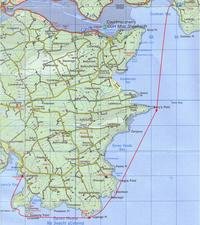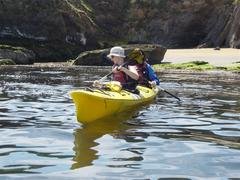Seven Heads trip
Earlier in the week I had made arrangements with Jon Hynes of H2O Sea Kayaking to join him and four other paddlers, Noelle, Gerard, Rob and Susan on a weekend expedition. The provisional plan was to paddle around the Seven Heads on Saturday, camp and go on towards Clonakilty on Sunday. On Friday Jon rang and asked if I had been watching the weather forecasts as the tail end of Hurricane Alex was stirring up a storm due to pick up from the south east at some time on Saturday afternoon. He suggested we get started as early as possible on Saturday to make the most of the available weather window but accepting that we might have to pull the plug at any stage.
 We set off from Coolmain beach and made directly for Barry�s Point across Coolmain Bay. The crossing was sheltered by The Old Head of Kinsale as the wind was in the south east and the small waves made it possible to paddle together in twos or threes chatting but we could see larger breaking waves � a sign of things to come - on Horse Rock as we approached Barry�s Point.
We set off from Coolmain beach and made directly for Barry�s Point across Coolmain Bay. The crossing was sheltered by The Old Head of Kinsale as the wind was in the south east and the small waves made it possible to paddle together in twos or threes chatting but we could see larger breaking waves � a sign of things to come - on Horse Rock as we approached Barry�s Point.
Once past the point we regrouped head to wind and swell, to discuss the next section. Jon explained that we would paddle across Seven Heads Bay towards Vregira Point, then past another couple of headlands to Leganagh Point. From there, he explained, we would have about two kilometres which he described as the crux of the trip in that there was no landing place and we would have to keep paddling.
We made good progress across Seven Heads Bay with the swell growing as we lost the shelter of The Old Head. Now we were paddling directly across the waves having to lean into them as they approached the side of the boats and adopting a longer paddle shaft on the windward side to counter the wind and swell that was tending to turn us towards the shore.
As we rounded Vregira Point we passed a yacht going the other way just outside us, we exchanged waves and I imagined how mad they must think us to be out in what were now developing into quite adventurous conditions. From Vregira Point and beyond we found the waves increasingly large and confused around each headland with evident clapotis. This made it ever more difficult to predict which direction the next wave might strike from and heightened the need for constant observation all around one (while I was busy watching the waves Rob managed to spot a sunfish as we rounded Illaunbaun).
After we passed Reenreagh we again regrouped facing together into the waves and paddling slowly to hold our position. Jon checked how everyone was doing and I told him I was a little nervous of the growing swell and that I was suffering from a stiff right leg (I was afraid of cramp and had been trying to stretch and straighten it whenever the waves did not seem too threatening). Jon explained that we were now entering the crux and that once past the next headland (Leganagh Point) we would keep going quickly towards Dunworley Point which we could see adorned by a fortification set back from the tip of the promontory.

By the time we rounded Leganagh Point the swell had grown to about 1.5 metres and was coming from behind us across the windward quarter, this made things quite tricky as one could not see what was coming. Despite frequent glances over my left shoulder, there were inevitably some bigger waves that hit me unsighted requiring swift corrective action. At one point, a large wave broke right over me. I instinctively made a strong low brace into the wave on my left hand side and stayed steady while the water crashed over me. Jon and Noelle saw this and congratulated me on my brace. I had not seen the wave coming, as perhaps they had, and did not think it noteworthy but was glad that I had not lost my instinctive paddling skills.
I found the next section, the crux, much more threatening. This was not due to any immediate danger, but rather, to the intense and sustained concentration required to paddle a course, stabilising the boat as necessary, while watching out for waves from behind and keeping in contact with the rest of the group.
By the time we reached Dunworley Point I was longing for a break, not because I was physically tired, but just to be able to relax my concentration for a few minutes.
Rounding the point was again quite an anxious moment as the sea state had been steadily increasing and we were now very exposed. We were past the crux as we could have got in to Foilareal Bay but Jon had decided to go another 1.5 kilometres to Dunworley Bay which was a preferable camp site.
 Once around the point we cut across the small bay and made for the narrow channel between the headland and Bird Island. Jon went in first and found a position facing outwards where he could hold station and call the rest of us in one by one whenever there was a break in the waves. When my turn came my adrenaline surged as I paddled like mad for the calm water beyond the rocky gap, silently uttering a prayer that I would get there before the next wave.
Once around the point we cut across the small bay and made for the narrow channel between the headland and Bird Island. Jon went in first and found a position facing outwards where he could hold station and call the rest of us in one by one whenever there was a break in the waves. When my turn came my adrenaline surged as I paddled like mad for the calm water beyond the rocky gap, silently uttering a prayer that I would get there before the next wave.
I negotiated the channel safely and passed into the sheltered water behind Bird Island. Finally, I was able to relax and I drifted gently for a minute with my paddle resting across my boat feeling slightly giddy as my nervous energy dissipated.

When the whole party was safely through we laughed and congratulated ourselves and found an even more sheltered spot in a sea cave where we were able to stop, admire the scenery, share some coffee and take pictures.
After a little rest we paddled out of the cave and into the calm water of Dunworley Bay taking time to explore another dramatic sea arch on the way in to the slipway beneath our camp site. Again, Jon went in first calling us each in turn onto the slipway, between the bigger waves, from where we carried the boats up to some conveniently located picnic tables for lunch.
 Our total distance travelled for the day was about 14 kilometres.
Our total distance travelled for the day was about 14 kilometres.
On Sunday morning the sea state had risen substantially and Jon made the decision to abandon any further hope of paddling as launching, let alone landing, through the surf would be too challenging.
Additional photos from this trip are available here.



